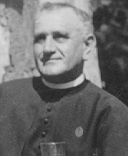Throughout many years the church services were held in a sort of "Hambar" or prayer house (House number 76) in School Lane. From 1797 onwards, Neupanat was an independent parish, but it was only in 1819 that the foundation stone for the new church was laid by the landowner, Count Ignatz Gyulai. Up until 1824, only the bare bones of the structure stood. When the parish priest, Georg Quesar of Persanova, died on 29th January 1825, he left 1,011 Gulden in his will for the completion of the church. An additional 2 Gulden was collected from every house so that the building could be finished as soon as possible. On the first Advent Sunday of the same year (November 27th, 1825), the church was consecrated by the Dean of the district, Johann Nyeky (the priest in Petschka).
The painting above the main altar was a gift from the Duke, which he had brought with him when he came from Vienna. The founder of the Jesuit order, Ignatius of Loyola, was named as the patron saint of the church. The parish priest at the time, Joachim Valentin Fliegssseder, was also involved considerably in the building of the church. This clergyman settled down to parochial duties and began writing the Historie Domus, which unfortunately has now been lost. Father Fliegssseder was clergyman for 19 years in the village. He died in 1843 and found his last resting place in Neupanat cemetery.
In 1835, an organ was given to the church and was still in use until at least 1903. The current presbytery was built in 1846, courtesy of Count Franz Gyulai, and in 1886 a further room was added on. The tower clock was sponsored by Baron Bohus, although this stopped working during the 1920s and was only replaced in 1926. Unfortunately, it has stood still again for the past two years as no-one can repair it anymore.
In 1862 and 1892, the church had a new roof made of shingle, paid for by the patron, Count Gyulai. In 1925, the church foundations were renewed and in 1995 the church roof was replaced, with the help of the Neupanat HOG, with tin plate.
Spiritually, those who made a particular impression were:
